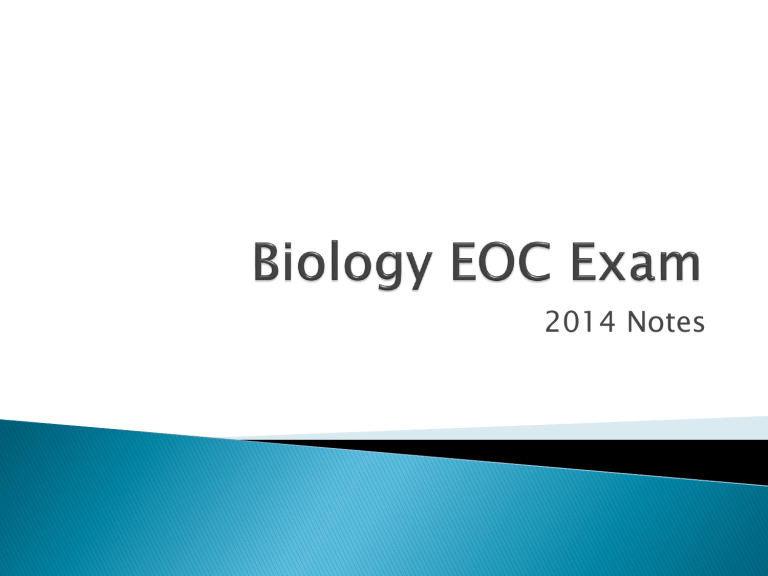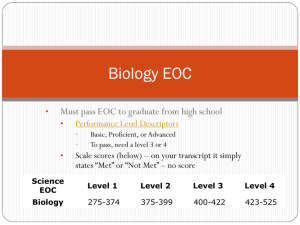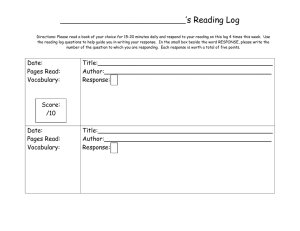2014 Notes

2014 Notes
5-6 scenarios
Inquiry (Field Study and Controlled Investigation)
Application
Systems
45 total questions (5 are pilot items)
35 Mult. Choice or Completion
5 Short Answer Questions
Types of Scenarios
Systems Inquiry
• Diagram of a system and some text about a specific system.
• May include systematic observations, models, or openended explorations of a system.
• Documentation of the steps of a controlled experiment or field study.
• Data table with the results.
Application
• Documentation of the use of the technological design process to solve a problem.
• Table with test results.
50% - Cross-cutting standards
Inqiury (8 questions)
Systems (6 questions)
Application (6 questions)
50% - Content Standards
LS1 Structure and Function (9 questions)
LS2 Ecology and Populations (6 questions)
LS3 Biological Evolution (5 questions)
Biology EOC Test Map
EALR
1: Systems (crossed with Life Science and alone)
2: Inquiry (crossed with Life Science and alone)
3: Application (crossed with Life Science and alone)
4: Life science domain of EALR 4 (alone)
Percent of EOC
At least 15
20 – 25
15
45 – 50
Biology EOC Test Map
Life Science Domain of EALR 4
Percent of EALR 4
Items
Percent of EOC
Points
40-45 20-23 Processes in cells (LS1)
Maintenance and stability of populations (LS2)
Mechanisms of Evolution (LS3)
30-35
25-30
15-18
14-16
Biology EOC Number and Types of Items
Item Type
Multiple Choice
Completion
Short Answer
Total Items
Total Points
Pilot Items
Biology EOC
30-34
1-5
5
40
45
5
The Birds and the Beaks
Completion Item
◦ 1 point item
◦ Can rank higher on the DOK scale than MC
◦ Rubrics include lists of accepted responses
8
Foaming Spuds
Conclusion
◦ 5 attributes
◦ New attribute- Scientific Explanation
9
Foaming Spuds New Procedure
◦ 7 attributes
◦ Extra Validity measure
◦ Experimental Control Condition (when appropriate)
10
Field Study Template 7 Attributes
◦ Similar to controlled investigations but…
◦ Need to have 3 “conditions” instead of one controlled variable
◦ Example: Which surface on the school campus will get hotter?
Compare asphalt, bare soil, and grass
11
Application scenarios describe a technological design process students use to solve a problem.
The problem must be one that involves a
Life Science System*
Blueberry Plant
List the steps of a technological design process to help farmers with improve yield of blueberry plants.
The Steps
Define the Problem
Gather Information
Generate Ideas
Test Ideas
Redesign as needed
Communicate results
Test Questions that kids will be asked?
Research the Problem
Criteria and
Constraints
Test a solution
Redesign
Jose and Tasha want to improve the soil in the garden by increasing the population of worms in the soil. Describe how to begin solving this problem.
Science Standards
Glossary
Systems.
An assemblage of interrelated parts or conditions through which matter, energy and information flow
.
Subsystems in this System
Producers
Herbivore
Omnivore
Carnivore
Decomposers
Self Regulating (Negative)
Generally over time
Self Reinforcing (Positive)
During short time periods
Systems it is connected to.
Biome
Seasons
Food Web
Carnivore population
Predict the results of a change in the system.
Migration of new carnivores into the area will change the balance of a carnivore population
Inputs that regulate the system.
Matterprey population
Energychemical
Equilibrium:
Static Dynamic input = output?
Terrariums with limited biodiversity may be used to model real food webs.
These models are limited because they rarely include all the species in an actual environment.
Output of the system
MatterCarnivore Population
EnergyChemical
Reliability: An attribute of any investigation that promotes consistency of results during repeated trials.
Validity: An attribute of an investigation that describes the degree of confidence that data collected and logical inferences are accurate representations of the phenomena being investigated.
SHORT ANSWER
Answer both bullets when there are two. Example:
◦ Describe two ways to solve the problem. In your description be sure to:
Identify two solutions to the problem
Describe how each solution will solve the problem
Students very often identify two solutions to the problem, but do not attempt the second bullet.
They generally must at least attempt to address the second bullet to earn any points.
19
CONCLUSIONS
Write a complete comparison – don’t write, “ the amount of water does have an effect on the plant height.” Instead, say:
◦
◦
◦ Plant A grew the tallest;
Plant A grew taller than plant B and plant C;
The more water the plant had, the taller the plant grew .
Include supporting data and/or descriptive text from the data table.
◦ Quote from the data table.
◦ Be specific – cite data exactly as given in tables.
20
NEW PROCEDURES
Be sure to write the steps for a procedure when asked, not a conclusion or prediction.
The manipulated (independent) and responding
(dependent) variables don’t need to be specifically named or listed (e.g., Manipulated variable is water temperature ) to receive credit for them; the variables just need to be used correctly in the procedure to be credited.
Sometimes students switch the identities of the manipulated and responding variables and contradict their procedure.
21
NEW PROCEDURES
Be very clear about what you are measuring.
Many students write “ record the data,” “measure the data,” or “watch what happens and record the measurements” without actually stating the
“ responding variable. They should write things like record the number of organisms in the sample area,” “measure the height of the plant,” or
“measure the time for seeds to germinate” to earn credit for the responding variable.
22
NEW PROCEDURES
Write procedures that use the manipulated
(independent) and responding (dependent) variables given in the new experimental or field study question.
Don’t use the same responding variable as was used in the original scenario. A procedure that does not use the correct manipulated variable cannot answer the investigative question and no points can be earned on the item.
23
GENERAL ISSUES
When given a model of a complex system lacking sufficient detail to make reliable predictions about that system, students are unable to describe the inadequacies of the model .
Students have difficulty identifying positive and/or negative feedback systems.
Students have difficulty distinguishing between steps in an investigation that increased reliability and steps that increased validity.
Many students are unable to identify roles and relationships among DNA, chromosomes, genes, ribosomes and proteins.
24
GENERAL ISSUES
Students demonstrate misconceptions about cellular respiration, especially in the context of plants.
Students often are unable to identify the number of chromosomes in sex cells versus body cells or after the processes of mitosis, meiosis or fertilization.
Students struggle to identify the processes that regulate the flow of substances into and out of the cell (e.g., active transport, osmosis).
Students struggle with identifying the path of a carbon atom during photosynthesis and/or cellular respiration.
25
GENERAL ISSUES
Students showed little understanding of the nitrogen cycle.
Students demonstrate misconceptions about the mechanisms of evolution (e.g., genetic variability due to sexual reproduction, effect of natural selection on populations).
26


